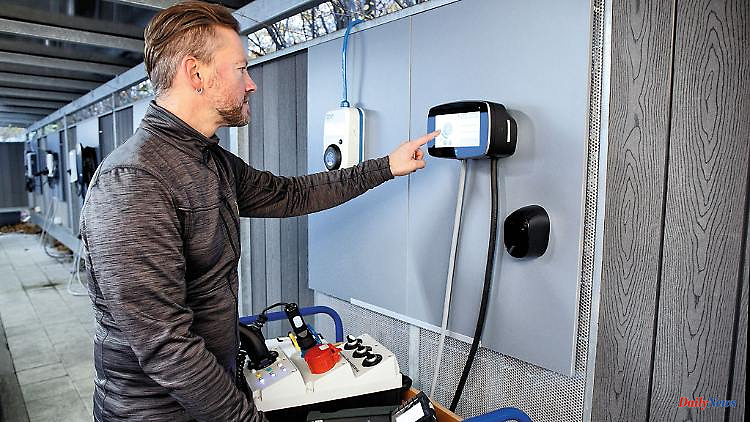Do e-cars burn more often than combustion engines? There is no evidence for this. But outdated electrics for charging in your own garage can be a fire hazard. The wall box is a must.
Millions in damage from burning electric buses in Paris, Stuttgart or Hanover, electric vehicle fires in Staufen, Offenburg or Schorndorf - when electric vehicles burst into flames, the damage is often immense. The attention too. Discomfort is also caused when the cause of a nighttime garage fire cannot be clarified.
Are electric vehicles an underestimated danger?
Fire protection researchers see no reason for particular concern. "From our statistics, we have no evidence that electric vehicles catch fire more often than cars with combustion engines," says Jörg Asmussen, General Manager of the German Insurance Association (GDV).
This coincides with observations by the police and fire brigade - but not necessarily with the gut feeling of the public. According to a survey by the market research institute YouGov on behalf of DEVK-Versicherungen, 49 percent of those surveyed believe that electric vehicles catch fire faster than vehicles with combustion engines. Older people in particular assess the risk of fire from electric cars as higher.
How can this be explained?
There are no official statistics on e-car fires. However, the Baden-Württemberg Ministry of the Interior points to the steady increase in vehicles with alternative drive systems. "As a result, the number of electrically powered vehicles involved in accidents and fires is also increasing per se."
At the beginning of the year, according to the Federal Motor Transport Authority (KBA), there were around 2.3 million battery-powered cars (618,460 purely electric cars, 1.67 million hybrids). Since the beginning of 2013, the population in Germany has increased more than 30 times. The GDV expects seven to ten million registered electric vehicles by 2030.
Do increasing numbers of e-cars mean increasing fire risks?
Car manufacturers refer to the multi-level safety system of battery-powered cars. This should rule out overheating and overcharging in every operating state. According to the experience of the expert organization Dekra, there are risks when charging that do not exist with conventionally powered vehicles.
At the same time, there are no combustion-specific causes of fire in purely electric vehicles. "So there is a shift in risk without, in our view, increasing the overall risk," says a Dekra spokesman.
Fires involving e-cars are still relatively rare. Frank Hachemer, Vice-President of the German Fire Brigade Association (DFV), expects more e-cars to cause more fires in e-vehicles. This is a challenge for the fire brigade: Such fires have to be extinguished with a large amount of water so that the cooling effect can take effect. You can adapt to that, says Hachemer. But: "It's an old wives' tale that fires with lithium-ion batteries cannot be extinguished."
Battery defects can lead to overheating or overcharging, and broken emergency charging cables can also be a fire hazard. Dekra and ADAC also point out the risk of smoldering and cable fires caused by outdated or overloaded electrical installations in the house.
For safety reasons, the car club advises against regular charging at household sockets. According to Dekra, it becomes even more problematic if the vehicle is charged in community garages using an emergency charging cable at existing Schuko sockets.
For safety reasons, charging at a standard household Schuko socket should be restricted to exceptional cases, according to the ADAC. The sockets are designed for domestic use and similar applications. When charging e-vehicles for several hours, increased resistance in the circuit can occur due to aging processes in the contacts, at terminal points in the supply line or due to improper installation. This can lead to excessive heating and thus to the risk of fire.
The recommendation: a permanently installed charging station - the so-called wall box. The ADAC tested 12 models at the end of February 2022. The price range of the devices in the test ranged from 675 to 1570 euros. There are also individual installation costs. But here, too, the upstream network installation has to fit.
What is to be considered?
The Central Association of German Electrical and Information Technology Trades (ZVEH) strongly recommends a check of the electrical system by a specialist electrical company. "Charging vehicles is safe if the standards are observed," says Andreas Habermehl, the association's technical director.
Without checking, an overload might initially go undetected. It is even more dangerous if a layman lends a hand. A charging station is a major intervention in the electrical system. "You can't compare it to connecting a washing machine or an electric stove."
Habermehl also strongly advises against charging an e-car for a long period of time using a normal socket: "Depending on the power, overloading can occur very quickly and the socket can catch fire." Charging cables for the socket are only an emergency solution, for example when on the go.
According to Mercedes-Benz, any type of energy storage device, whether fuel tank or battery, is basically combustible. Police add: Where there are electrics, there can be malfunctions. It is not always clear what exactly started a fire. "If everything is burned, we can't do magic," says a Pforzheim fire investigator.
When an e-car catches fire, it is not necessarily always the cause: at the end of March, for example, pellets stored in a barn caught fire in Neuenstein (Hohenlohe district) before the flames spread to an e-car parked there. And sometimes small things have big consequences: In May, for example, a fire engine caught fire in Sigmarszell (Lindau district) - according to the police investigation, the battery of a flashlight in the vehicle had ignited by itself.












